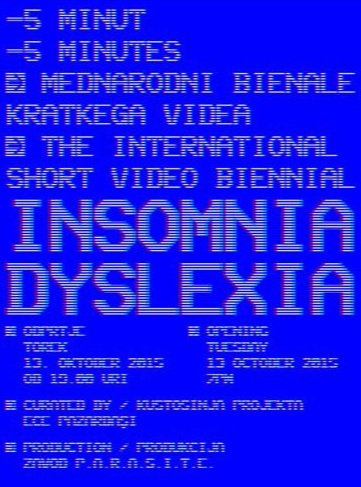INSOMNIA DYSLEXIA
5th -5 MINUTES Ljubljana Biennial of Short Video / P.A.R.A.S.I.T.E. Institute / P74 Gallery
13 October – 3 November 2015
Artists:
Bonnie Begusch
Anupong Charoenmitr
Heidi Hörsturz
Sanja Hurem
Local A
Dustin Luke Nelson
Guido Nosari
Insomnia Dyslexia is an unofficial term that defines the outcome when lack of sleep results in misspelling, mispronouncing or misacting. Dyslexia caused by insomnia prevents one from generating a coherent sentence in a conversation or a fluid movement in action. Insomnia can cause a mystified result in written, oral or behavioral acts, or in all of these forms. The notion is that a transformed product (dyslectic outcome) appears because of a human being’s basic broken (sleep) pattern. It appears as the very moment when what the mind thinks and what the body utters do not match. Although the thought and the said are not co-ordinated, at the same time their combination describes the reality of the current moment fully. Be it a Freudian slip or not, the transformed utterance/act (within its own system) is always as meaningful as the thought utterance/act. And both the transformed outcome and the dyslectic outcome stem from the same source, that is, from the same individual. Although the transformed outcome and the dyslectic outcome may divert from each other in terms of content, the presence of the source makes them compatible. That is, the act or the word from the insomniac source and what the act or word could have been coming from a “well-slept” source complete each other. The intended word/act and the dyslectic outcome are the two parts of a whole within their own concept. The act in the mind of the source starts anyway as a non-dyslectic act, yet when it is externally expressed, it becomes a dyslectic fact.
